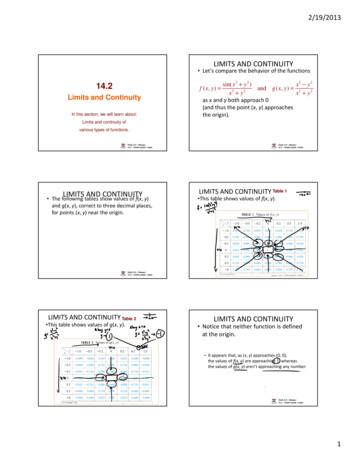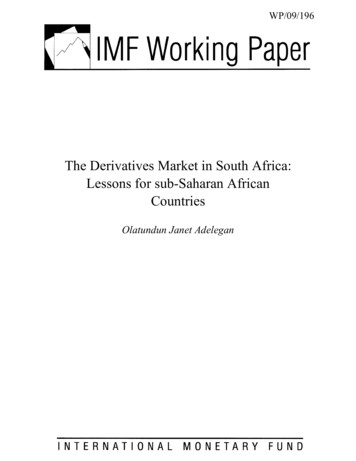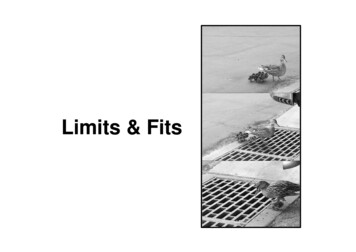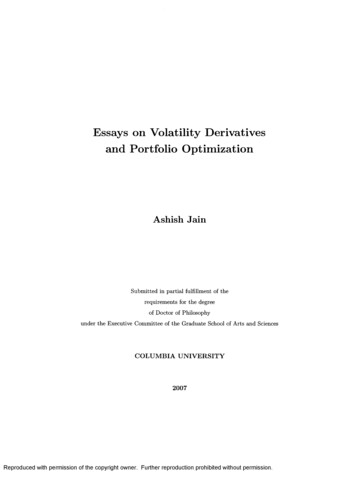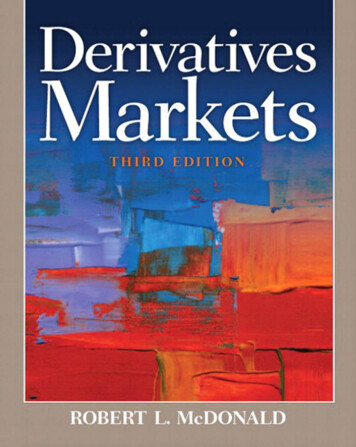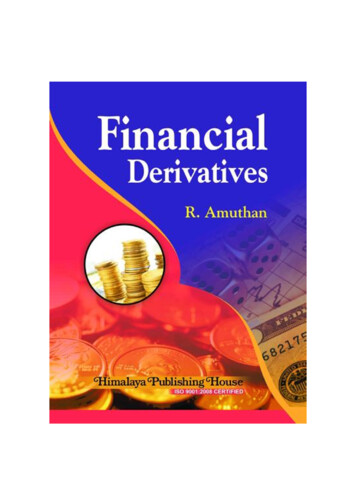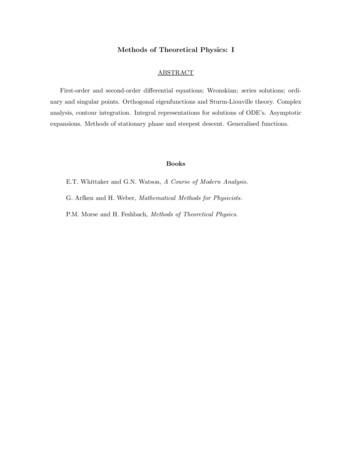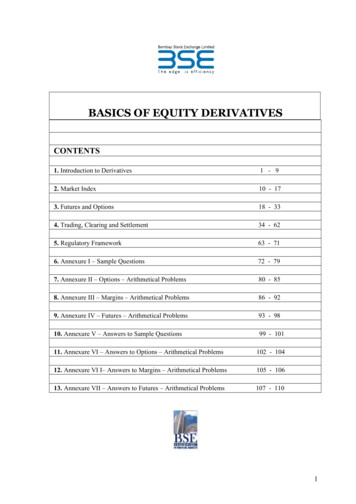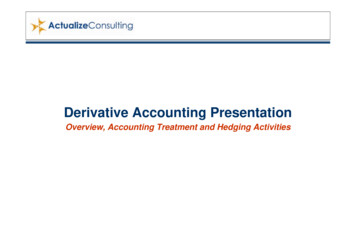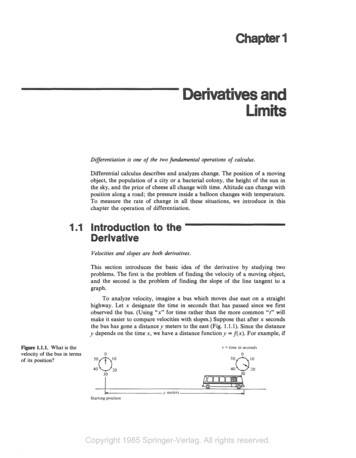
Transcription
Chapter 1Derivatives andLimitsDifferentiation is one of the two fundamental operations of calculus.Differential calculus describes and analyzes change. The position of a movingobject, the population of a city or a bacterial colony, the height of the sun inthe sky, and the price of cheese all change with time. Altitude can change withposition along a road; the pressure inside a balloon changes with temperature.To measure the rate of change in all these situations, we introduce in thischapter the operation of differentiation.1 ."0,lntrodiaaetlon to theDerivativeVelocities and slopes are both derivatives.This section introduces the basic idea of the derivative by studying twoproblems. The first is the problem of finding the velocity of a moving object,and the second is the problem of finding the slope of the line tangent to agraph.To analyze velocity, imagine a bus which moves due east on a straighthighway. Let x designate the time in seconds that has passed since we firstobserved the bus. (Using "x" for time rather than the more common "t" willmake it easier to compare velocities with slopes.) Suppose that after x secondsthe bus has gone a distance y meters to the east (Fig. 1.1.1). Since the distancey depends on the time x, we have a distance function y f(x). For example, ifFigure 1.1.1. What is thevelocity of the bus in termsof its position?.r time in seconds2040-b2040y mrtersAStarting positionCopyright 1985 Springer-Verlag. All rights reserved.
50Chapter 1 Derivatives and Limitsf(x) happens to be f(x) 2x2 for 0 x , 5, then the bus has gone 2 - (3)* 18 meters after 3 seconds and 2 . (512 50 meters after 5 seconds.The velocity of the bus at any given moment, measured in meters persecond, is a definite physical quantity; it can be measured by a speedometeron the bus or by a stationary radar device. Since this velocity refers to a singleinstant, it is called the instantaneous velocity. Given a distance function such asy f(x) 2x2, how can we calculate the instantaneous velocity at a specifictime x,, such as x, 3 seconds? To answer this question, we will relate theinstantaneous velocity to the average velocity during short time intervals.Suppose that the distance covered is measured at time x, and again at alater time x; these distances are yo f(x,) and y f(x). Let Ax x - x,designate the time elapsed between our two measurements.' Then the extradistance covered is y -yo, which we designate by Ay y -yo. The average velocity during the time interval Ax is defined simply as the distancetravelled divided by the elapsed time; that is, average velocity Ay/Ax [ f(x) - f(xo)]/Ax. Since x x, Ax, we can also writeaverage velocity f(x0 Ax) - f(x0)AxExample IA bus travels 2x2 meters in x seconds. Find Ax, Ay and the average velocityduring the time interval Ax for the following situations: (a) x, 3, x 4;( b ) x 0 3 , x 3.1; (c)x, 3, x 3.01.Soiiletlon(a) Ax x - x, 4 - 3 1 second, Ay f(x, Ax) - f(x,) f(4) - f(3) 2 .4' - 2 - 3' 14 meters, average velocity Ay/Ax 14 meters per second; (b) Ax 0.1, Ay 1.22, average velocity 12.2; (c) Ax 0.01, Ay .1202, average velocity 12.02 meters per second. AIf we specify the accuracy to which we want to determine the instantaneousvelocity, we can expect to get this accuracy by calculating the average velocityAy/Ax for Ax sufficiently small. As the desired accuracy increases, Ax mayneed to be made even smaller; the exact velocity may then be described as thenumber v which Ay/Ax approximates as Ax becomes very small. For instance, in Example 1, you might guess that the instantaneous velocity atxo 3 seconds is v 12 meters per second; this guess is correct, as we will seeshortly.Our description of v as the number which Ay/Ax approximates for Axvery small is a bit vague, because of the ambiguity in what is meant by"approximates" and "very small." Indeed, these ideas were the subject ofcontroversy during the early development of calculus around 1700. It wasthought that Ax ultimately becomes '6infinitesimal,"and for centuries peopleargued about what, if anything, "infinitesimal" might mean. Using the notionof "limit," a topic taken up in the next section, one can resolve thesedifficulties. However, if we work on an intuitive basis with such notions as"approximates," "gets close to," "small," "very small," "nearly zero," etc., wecan solve problems and arrive at answers that will be fully justified later.Example 2The bus has gone f(x) 2x2 meters at time x (in seconds). Calculate itsinstantaneous velocity at x, 3.'A is the capital Greek letter "delta," which corresponds to the Roman D and stands fordifference. The combination "Ax", read "delta-x", is not the product of A and x but rather asingle quantity: the difference between two values of x.Copyright 1985 Springer-Verlag. All rights reserved.
1.1 Introduction to the DerivativeSolution51We choose Ax arbitrarily and calculate the average velocity for a time intervalAx starting at time x , 3 :aY- - f ( 3Ax Ax) -f(3)Ax-2(3 AX) - 2 .3'AxIf we let Ax become very small in this last expression, 2 A x becomes small aswell, and so A y / A x 12 -k 2 A x approximates 12. Thus the required instantaneous velocity at x, 3 is 12 meters per second. Note how nicely the 18'scancelled. This allowed us to divide through by Ax and avoid ending up witha zero in the denominator. AWarningIn calculating what A y / A x approximates for Ax nearly zero, it usually doesno good to set Ax 0 directly, for then we merely get 0 / 0 , which gives us noinformation.The following more general procedure is suggested by Example 2.To calculate the instantaneous velocity at x , when the position at time x1. Form the average velocity over the interval from x , to x, Ax:-2. Simplify your expression for A y / A x as much as possible, cancellingAx from numerator and denominator wherever you can.3. Find the number v that is approximated by A y / A x for Ax small.Example 3The position of a bus at time x is y 3 x 2 8 x for x 0 . (a) Find theinstantaneous velocity at an arbitrary positive time x,. (b) At what time is theinstantaneous velocity 1 1 meters per second?Solution(a) The calculation is similar to that of Example 2, except that x , no longerhas the specific value x , 3. The average velocity for a time interval Axstarting at x , isf ( x o Ax - f (xo)AxAxwhere f ( x ) 3 x 2 8 x . ThusAy -As Ax gets close zero, the term 3 Ax gets close to zero as well, so A y / A x getsclose to (that is, approximates) 6 x o 8. Thus our instantaneous velocity isv 6 x 0 8 meters per second at the positive time x,.Copyright 1985 Springer-Verlag. All rights reserved.
52Chapter "Ierivativesand Limits(b) We set the velocity equal to 11: 6x0 8 11. Solving for xo givesx, 4 second. AThe second problem we study is a geometric one-to find the slope of the linetangent to the graph of a given function. We shall see that this problem isclosely related to the problem of finding instantaneous velocities.To solve the slope problem for the function y f(x), we begin bydrawing the straight line which passes through the points (x,, f(x,)) and(x, Ax, f(xo Ax)), where Ax is a positive number; see Fig. 1.1.2. Thisstraight Iine is called a secant line, and Ay/Ax [f(xo Ax) - f(xo)]/Ax isits slope.As Ax becomes small, x, being fixed, it appears that the secant line comesclose to the tangent line, so that the slope Ay/Ax of the secant line comesclose to the slope of the tangent line. See Fig. 1.1.3.Figure 1.1.2. AylAx is theslope of the secant line.Figure 1.1.3. The secantline comes close to thetangent line as the secondpoint moves close to xo.Given a functiony f(x), the slope rn of the line tangent to its graph at(x,, yo) is calculated as follows:1. Form the slope of the secant line:f (xo Ax) - f (xo)Example 4SolullonCalculate the slope of the tangent line to the graph of f(x) x2 1 atx, - 1. Indicate your result on a sketch.We form the slope of the secant line:For Ax small, this approximates - 2, so the required slope is - 2. Figure 1.1.4Copyright 1985 Springer-Verlag. All rights reserved.
I.IIntroduction to the DerivativeFigure 1.1.4. The tangentline toy x2 1 atx, - 1 has slope - 2.53Y x 1shows the graph of the parabola yline through the point (- 1,2). A x2 1. We have sketched the tangentWe define the slope of the graph of the function f at (x,, f(xo)) to be the slopeof the tangent line there.Up to this point, we have drawn all the pictures with Ax positive.However, the manipulations in Examples 2, 3, and 4 are valid if Ax has anysign, as long as Ax f 0. From now on we will allow Ax to be either positive ornegative.Comparing the two previous boxes, we see that the procedures forcalculating instantaneous velocities and for calculating slopes are actuallyidentical; for example, the velocity calculation of Example 2 also tells us theslope m of y 2 x 2 at (3,181, namely m 12. We will later find that the sameprocedure applies to many other situations. It is thus convenient and economical to introduce terms which apply to all the different situations: instead ofcalling A y / A x an average velocity or the slope of a secant, we call it advference quotient; we call the final number obtained a derivative rather thanan instantaneous velocity or a slope. We use the notation f'(xo) to designatethe derivative off at x,.The DerivativeTo calculate the derivative f'(xo) of a function y f(x at x,:1. Form the difference quotientAy--f (xo A x ) - f ( x o )AxAx2. Simplify A y / A x , cancelling Ax if possible.3. The derivative is the number f'(x,) that Ay/Ax approximates for A xsmall.This operation of finding a derivative is called dqferentiation.The reader should be aware that the precise version of Step 3 involves thenotion of a limit, which is discussed in the next section.Example 5SolutionSuppose that m is a constant. Differentiate f ( x ) mx 2 at x, 10.Here the function is linear, so the derivative should be equal to the slope:f'(10) rn. To see this algebraically, calculateCopyright 1985 Springer-Verlag. All rights reserved.
54Chapter 1 Derivatives and LimitsThis approximates (in fact equals) m for Ax small, so f'(10) m. AGlancing back over our examples, we notice that all the functions have beeneither linear or quadratic. By treating a general quadratic function, we cancheck our previous results and point the way to the goal of developing generalrules for finding derivatives.Let f(x) ax2 bx c, where a , b, and c are constants, and let x, beany real number. Then f'(x,) 2ax0 b. To justify the quadratic function rule, we form the difference quotient--a(x, 4x12 b(xo Ax) c - ax:-bx, - cAx2sx, Ax 2ax0 a( b 4 ) b AxAxa Ax.As Ax approaches zero, a Ax approaches zero, too, so Ay/Ax approximates2ax, b. Therefore 2a.xo h is the derivative of ax2 hx c at x x,. Example 6 Find the derivative of f(x) 3x2 8x at (a) x, - 2and (b) x, Solution (a) Applying the quadratic function rule with a 3, b 8, c 0, and x, -2, we find f'(-2) 2(3)(-2)8 -4.(b) Taking a 3, b 8, c 0 and x, 5, we get f '(4) 2 - 3 . (4) 8 11,which agrees with our answer in Example 3(b). A If we set a 0 in the quadratic function rule, we find that the derivative ofany linear function bx c is the constant b, independent of x,: the slope of alinear function is constant. For a general quadratic function, though, thederivative f'(x,) does depend upon the point x, at which the derivative istaken. In fact, we can considerf' as a new function; writing the letter x insteadof x,, we have f'(x) 2ax b. We can rephrase the quadratic function rulewith x, replaced by x as in the following box, which also summarizes thespecial cases a 0 and a 0 b. The derivative of the linear function f(x) bx cThe derivative of the constant function f ( x )is the zero function cis the constantCopyright 1985 Springer-Verlag. All rights reserved.
1.9 Introduction to the Derivative55The next example illustrates the use of thinking of the derivative as a function. Example 7There is one point on the graph of the parabola y f(x) x 2 - 4x 5 wherethe slope is zero, so that the tangent line is horizontal (Fig. 1.1.5). Find thatpoint using: (a) derivatives; and (b) algebra.Solution(a) By the quadratic function rule with a 1, b -4, c 5, the derivativefunction is f'(x) 2x - 4. For zero slope we have 0 f'(x) 2x - 4, i.e.,x 2. Then y I, so our point is (2,l). This point is called the vertex ofthe parabola.(b) Completing the square gives f(x) x 2 - 4x 4 1 (x - 2)2 1. Now(x - 212 is zero for x 2 and positive othemise, so the parabola has itslowest point at x 2. It is plausible from the figure, and true, that this lowpoint is the point where the slope is zero. A" x * -4x 5 I 'We conclude this section with some examples of standard terms and notations. When we are dealing with functions given by specific formulas, we oftenomit the function names. Thus in Example 7(a) we can say "the derivative ofx2 - 4x 5 is 2x - 4." Another point is that we can use letters different fromx, y, and f. For example, the area A of a circle depends on its radius r ; we canwrite A g(r) ar2. The quadratic function rule with a a , b 0 c, with freplaced by g and with x replaced by r, tells us that g'(r) 2ar. Thus for acircle the derivative of the area function is the circumference function-a factwhose geometric interpretation will be discussed in Section 2.2. Similarly, thetime is often denoted by t in velocity problems.Example 8A stunt woman is on a moving passenger train. Her distance function is3t2 t. On the adjacent track is a long moving freight train. The distancefunction for the center of this freight train is t2 72. She must jump to thefreight train. What time is best?Figure 1.1.5. The vertex ofis the pointthewhere its slope is zero. SolutionThe safest time to jump is when the stunt woman has the same velocity as thefreight train (see Fig. 1.1.6). Her instantaneous velocity u is the derivative ofFigure 1.1.4. The stuntwoman should jump whenshe has the same velocity asthe freight train. 3t2 t . By the quadratic function rule, v 6t 1; similarly the instantaneousvelocity of the freight train is 2t 7. The velocities are equal when 21 7 6t 1, i.e., t 2 . That is the safest time. AIn this section, we have discussed the derivative, one of the two most basicconcepts of calculus. We showed how to find derivatives in some cases andCopyright 1985 Springer-Verlag. All rights reserved.
58Chapter 1 Derivatives and Limitsindicated a few of their applications. Before we can usefully discuss otherapplications of derivatives, we need to develop efficient techniques for calculating them. The next section begins that task.Exercises for Section 1.IIn Exercises 1-4, y represents the distance a bus hastravelled after x seconds. Find Ay and the averagevelocity during the time interval Ax for the followingsituations.(b) xo 2, Ax 0.01(a) x, 2, Ax 0.5(d) x, 4, Ax 0.01(c) xo 4, Ax 0.12. y 3 x 2 x1. y x 2 3 x3. y x 2 l o x4. y 2 xIn Exercises 5-8, f ( x ) is the number of meters a bus hasgone at a time x (in seconds). Find the instantaneousvelocity at the given time xo.6. x 2 3 x ; xo 45. x 2 3 x ; xo 28. 3 x 2 x ; x0 47. 3 x 2 x ; x0 2In Exercises 9-12, y is the position (measured in meters) of a bus at time x (in seconds). (a) Find theinstantaneous velocity at an arbitrary (positive) time x,.(b) At what time is the instantaneous velocity 10 metersper second?10. y 3x1 x9. y x 2 3 x12. y 2 x11. y 2 loxIn Exercises 13-16, use the A y / A x method of Example4 to find the slope of the tangent line to the graph ofthe given function at the given point. Sketch.13. y x 2 ; xo 114. y - x 2 ; x o 215. y 5 x 2 - 3 x 1 ; xo O16. y x 1 - x 2 ; x, 2In Exercises 17-20 use the A y / A x method of Example5 to compute the derivative of f ( x ) at x,; a is a constantin each case.17. f ( x ) a x 2; xo O18. f ( x ) 2x a ; xo 019. f ( x ) ax2; x, 120. f ( x ) 8 x 2 a ; x, 2In Exercises 21-24, use the quadratic function rule tofind the derivative of the given function at the indicatedpoint.21. f ( x ) x 2 X - 1 ; X o 122. f ( x ) x 2 - x ; x, 223. f ( x ) 3 x 2 x - 2; x, - 224. f ( x ) - 3 x 2 - x l ; x o - 1In Exercises 25-28, find the vertex of the given parabola using (a) derivatives and (b) algebra.25. y x 2 - 16x 226. y x 2 8 x 227. y - 2 x 2 - 8 x - 128. y - 2 x 2 - 3 x 5Gifferentiate the functions in Exercises 29-36 using thequadratic function rule.29.f(x) x2 3x-130. f ( x ) - 3 x 431. f ( x ) ( x - l)(x 1) 32. f ( x ) (9 - x)(l - x )33. g(r) -4t2 3t 6 34. g(r) ?rr2 335. g(s) 1 - s236. h ( t ) 3 t 2 - . S t 9 37. Inspector Clumseaux is on a moving passengertrain. His distance function is 2t2 31. On theadjacent track is a long moving freight train; thedistance function for the center of the freighttrain is 3t2 t. What is the best time for him tojump to the freight train?38. Two trains, A and B, are moving on adjacenttracks with positions given by the functions A ( t ) t 2 t 5 and B ( t ) 3t 4. What is the besttime for a hobo on train B to make a movingtransfer to train A?39. An apple falls from a tall tree toward the earth.After t seconds, it has fallen 4.9t2 meters. Whatis the velocity of the apple when t 3?40. A rock thrown down from a bridge has fallen4t 4.9t2 meters after t seconds. Find its velocity at t 3.41. f ( x ) x 2 - 2; find f'(3)42. f ( x ) - 13x2 - 9 x 5; find f'(1)43. f ( x ) 1 ; find f'(7)44. g ( s ) 0 ; find g'(3)45. k ( y ) ( y 4 ) ( y - 7 ) ; find k ' ( - 1)46. x ( f ) 1 - f 2 ; find xl(0)47. f ( x ) - x 2; find f'(3.752764)48. g(a) 10a - 8; find g'(3.1415)In Exercises 49-54, find the derivative of each of thegiven functions by finding the value approximated byA y / A x for Ax small:49. 4 x 2 3 x 250. ( x - 3)(x I )51. 1 - x 252. - x 253. - 2 x 2 5 x54. 1 - x55. Let f ( x ) 2 x 2 3 x 1 . (a) For which values ofx is f'(x) negative, positive, and zero? (b) Identify these points on a graph off.56. Show that two quadratic functions which havethe same derivative must differ by a constant.57. Let A ( x ) be the area of a square of side length x .Show that A ' ( x ) is half the perimeter of thesquare.58. Let A ( r ) be the area of a circle of radius r. Showthat A f ( r ) is the circumference.59. Where does the line tangent to the graph ofy x 2 at x, 2 intersect the x axis?60. Where does the line tangent to the graph ofy 2 x 2 - 8x 1 at x, 1 intersect they axis?61. Find the equation of the line tangent to thegraph of f ( x ) 3x2 4 x 2 at the point wherexo 1. Sketch.62. Find the tangent line to the parabola y x 2 3 x 1 when x, 2. Sketch.*63. Find the lines through the point (4,7) which aretangent to the graph of y x2. Sketch. (Hint:Find and solve an equation for the x coordinateof the point of tangency.) Copyright 1985 Springer-Verlag. All rights reserved.
1.2 Limitss64. Given a point (x,y), find a general rule fordetermining how many lines through the pointare tangent to the parabola y x2.r65. Let R be any point on the parabola y x2.Draw the horizontal line through R and draw theperpendicular to the tangent line at R. Show thatthe distance between the points where these linescross the y axis is equal to 4, regardless of thevalue of x. (Assume, however, that x 0.)r66. If j(x) ax2 bx c a(x - r)(x - s) ( r ands are the roots off), show that the values of f'(x)at r and s are negatives of one another. Explainthis by appeal to the symmetry of the graph.s67. Using your knowledge of circles, sketch theUse this to guess thegraph of f(x) JGf.values of f'(0) and f'(Q).*68. A trained flea crawls along the parabola y x 2in such a way that its x coordinate at time t is2t 1. The sun is shining from the east (positivex axis) so that a shadow of the flea is projected57on a wall built along the y axis. m a t is thevelocity of this shadow when t 3?r69. A ball is thrown upward at r 0; its height inmeters until it strikes the ground is 24.5t - 4.9t2when the time is t seconds. Find:(a) The velocity at t 0,1,2,3,4,5.(b) The time when the ball is at its highestpoint.(c) The time when the velocity is zero.(d) The time when the ball strikes the ground.*70. A toolbox falls from a building, its height y infeet from the ground after t seconds being givenby y q 100 - 16t2.(a) Find the impact time t*, i.e., the positivetime for which y 0.(b) Find the impact velocity, i.e., the velocityat t * .(c) The momentum p is defined by p Wu/32,where W is the weight in pounds, and u isthe velocity in feet per second. Find theimpact momentum for a 20-lb toolbox.The limit of a function f ( t ) at a point x x , is the value which f ( x ) approximates fir x close to x,,.In this section, we introduce limits and study their properties. In the followingsections, we will use limits to clarify statements such as " A y / A x approximatesf'(x,) for Ax small," and to systematize the computing of derivatives. Sometechnical points in the theory of limits have been deferred to Chapter 11,where limits are needed again for other purposes. Readers who wish to seemore of the theory now can read Section 11.1 together with the presentsection.We illustrate the idea of a limit by looking at the functionwhich is defined for all real numbers except 3. Computing values of f ( x ) forsome values of x near 3, we obtain the following tables:It appears that, as x gets closer and closer to x , 3 , f ( x ) gets closer and closerto 5, i.e., f ( x ) approximates 5 for x close to 3. As in our discussion of thederivative, it does no good to set x 3, because f ( 3 ) is not defined. In theCopyright 1985 Springer-Verlag. All rights reserved.
58Chapter 1 Derivatives and Limitsspecial case we are considering, there is another way to see that f ( x ) approximates 5:The cancellation of ( x - 3 ) is valid for x # 3. Now for x close to 3 , 2 x - 1approximates 2 . 3 - 1 5. Note that after cancelling x - 3 , the functionbecomes defined at x, 3.In general, suppose that we have a function f ( x ) and are interested in itsbehavior near some value x,. Assume that f ( x ) is defined for all x near x,, buinot necessarily at x x , itself. If the value f ( x ) off approximates a number Ias x gets close to a number xo, we say that " I is the limit of f ( x ) as xFigure 1.2.1. The notion oflimit: as x approaches x,f(x) gets near to I.approaches x," or " f ( x ) approaches 1 as x approaches x,." See Fig. 1.2.1. Twousual notations for this aref(x)- Ilim f ( x )X--SXi,as x x , I.For example, the discussion above suggests that2x2-7x 3 5x-3that islim 2 x 2 - 7 x 3x -3as x 3 ; 5.x-3Example 1SolullonUsing numerical computations, guess the value of limx,,[l/(4x - 2)].We make a table using a calculator and round off to three significant figures:It appears that the limit is a number which, when rounded to three decimalplaces, is 0.071. In addition, we may notice that as x 4 , the expression4 x - 2 in the denominator of our fraction approaches 14. The decimalexpansion of & is 0.071428 . . . , so we may guess thatWe summarize the idea of limit in the following display.Copyright 1985 Springer-Verlag. All rights reserved.
1.2 Limits59If the value of f(x) approximates the number I for x close to x,, then wesay that f approaches the limit I as x approaches x,, and we writef(x) las x x,,orlimf(x) I.X--fX',The following points should be noted.1. The quantity limx,,o f(x) depends upon the values of f(x) for x near x,,but not for x equal to x,. Indeed, even if f(x,) is defined, it can be changedarbitrarily without affecting the value of the limit.2. As x gets nearer and nearer to x,, the values of f(x) might not approachany fixed number. In this case, we say that f(x) has no limit as x x,, orthat lim,,xo f(x) does not exist.3. In determining limx,xo f(x), we must consider values of x on both sides ofxo.4. Just as in our discussion of the derivative, one can still legitimatelycomplain that the definition of limit given in the preceding display is toovague. Readers who wish to see an air-tight definition should now read thefirst few pages of Section 11.1. (Section 11.1 is needed for other theoreticalpoints in Chapter 11 and for proofs, but not for what follows here.)Example 2Reading the graph in Fig. 1.2.2, find lim,,,g(t)and 5.if it exists, for b 1, 2, 3, 4,Figure 1.2.2. Find thelimits of g at the indicatedpoints. A small circlemeans that the indicatedpoint does not belong tothe graph.SolutionNotice first of all that we have introduced new letters; lim, ,g(t) means thevalue approached by g(t) as t approaches b.b 1: lim, , g(t) 0.5. In this case, g(b) is defined and happens to beequal to the limit.b 2: lim,,,g(t) 1. In this case, g(b) is defined and equals 1.5, whichis not the same as the limit.b 3: lim,,,g(t) does not exist. For t near 3, g(t) has values near 0.5(for t 3) and near 1 (for t 3). There is no single numberapproached by g(t) as t approaches 3.b 4: lim, ,g(t) 1. In this case, g(b) is not defined.b 5: lim,,,g(t) does not exist. As t approaches 5, g(t) grows larger andlarger and does not approach any limit. AThe computation of limits is aided by certain properties, which we list in thefollowing display. We will make no attempt to prove them until Chapter 11.Instead, we will present some remarks and graphs which suggest that they arereasonable.Copyright 1985 Springer-Verlag. All rights reserved.
80Chapter I Derivatives and LimitsAssume that limx,xo f(x) and limx,xog(x) exist:Constant function rule:Identity function rule:Replacement rule: If the functions f and g have the same values for all xnear x,, but not necessarily including x x,, thenThe sum and product rules are based on the following observation: If wereplace the numbers y , and y2 by numbers z , and z2 which are close toy, andy,, then z , 2, and z ,z, will be close to y , y2 and y , y2, respectively.Similarly, the reciprocal rule comes from such common sense statements as"1/14.001 is close to 1/14."The constant function rule says that if f(x) is identically equal to c, thenf(x) is near c for all x near x,. This is true because c is near c.The identity function rule is true since it merely says that x is near x, if xis near x,. Illustrations of the constant function rule and the identity functionrule are presented in Fig. 1.2.3. Fiyre 1.23. In (a)lirn,,,nc c and in (b)Finally, the replacement rule folIows from the fact that Iim,,,of(x)depends only on the values of f(x) for x near x,, and not at x, nor on valuesof x far away from x,. The situation is illustrated in Fig. 1.2.4.Example 3Use the basic properties of limits: (a) to find lim,,,(x2 2x 5); (b) to showlim,-,[(2x2 - 7x 3)/(x - 3)J 5 as we guessed in the introductory calculation at the start of this section, and (c) to find lim, ,[(8u2 2)/(u - I)].Copyright 1985 Springer-Verlag. All rights reserved.
1.2 LimitsFigure 1.2.4. If the graphs61Yoff and g are identical nearx,, except possibly at thesingle point where x xo,then lirn,,,o f(x) lirnx- xog(x).Solution(a) Common sense suggests that the answer should be 32 2 . 3 5 20. Infact this is correct.By the product and identity function rules,lim x2 lim (x . x) x 3x-3By the product, constant function, and identity function rules,By the sum rule,Finally, by the sum and constant function rules,(b) We cannot use common sense or the quotient rule, sincel i m ( x - 3 ) limx- l i m 3 3 - 3 0 .x 3x-3x 3Since substituting x 3 into the numerator yields zero, x - 3 must be afactor; in fact, 2x2 - 7x 3 (2x - l)(x - 3), and we haveFor x # 3, we can divide numerator and denominator by x - 3 to obtain2x - 1. Now we apply the replacement rule, withf ( x ) 2x2 - 7xand g(x) 2x - 1x-3since these two functions agree for x # 3. Therefore lim 2 x 2 - 7 x f lim(2x- 1 ) 2- I 2 . 3 - 1 5.x -3x-3(c) Here the letter "24" is used in place of "x," but we do not need to changeour procedures. By the sum, identity, and constant function rules, we getlim,,,(u - 1) limU,,u - lim,,,l 2 - 1 1. Similarly,x 3lim (8u2 2)u-2 lim8u2 lim2u-2u-2(sum rule)(product and constant function rules)(product and constant function rules) 8.2-2 2 34(identity function rule).Copyright 1985 Springer-Verlag. All rights reserved.
62Chapter 1 Derivatives and LimitsThus, by the product and reciprocal rules,limu 28uifZ limu-1u-t2 (8u2 2) -lirn (8 u2 2) . 2-( U- 1)1I 3lim (u - 1)4 . 1 34.1u- 2This agrees with the common sense rule obtained by substituting u 2. gAs you gain experience with limits, you can eliminate some of the steps usedin the solution of Example 3. Moreover, you can use some further rules whichcan be derived from the basic properties.Assume that the limits on the right-hand sides below exist. Then weExtended sum rule:Extended product rule:Constant mubiple rule:(n 0, I, 2, 3, . . . and x, .f 0 if n is not positive).We outline how these derived properties can be obtained from the basicproperties. To prove the extended sum rule with three summands from thebasic properties of limits, we must work out lim,,,o( f,(x) f2(x) f3(x))when lim,,xoj(x) is known to exist. The idea is to use the basic sum rule fortwo summands. In fact fl(x) f2(x) f3(x) f 1 ( ) g(x), where g(x) f2(x) f3(x). Note that lim,,,og(x) limx-txof2(x) limx,,o f,(x) by thebasic sum rule. Moreover lim,,x f,(x) g(x)) lirnx,,o f,(x) limx,,og(x)by the same rule. Putting these results together, we have hlo g(x) lirn f,(x) lim f2(x) lirn f3(x),x9xo lirn fl(x)x3xox-X,,X-JX,,as we set out to show. The extended sum rule with more than three terms isnow plausible; it can be proved by induction (see Exercise 65).
50 Chapter 1 Derivatives and Limits f(x) happens to be f(x) 2x2 for 0 x , 5, then the bus has gone 2 - (3)* 18 meters after 3 seconds and 2 .(512 50 meters after 5 seconds. The velocity of the bus at any given moment, measured in meters per second, is a definite physical quantity; it can be measured by a speedometer
